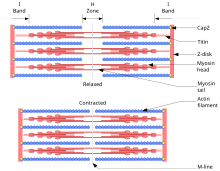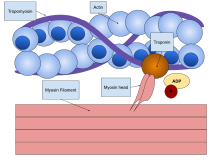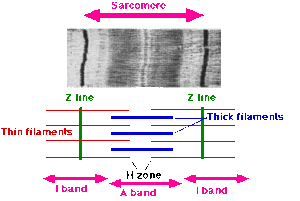Sliding filament theory

The sliding filament theory explains the mechanism of
The theory was independently introduced in 1954 by two research teams, one consisting of Andrew Huxley and Rolf Niedergerke from the University of Cambridge, and the other consisting of Hugh Huxley and Jean Hanson from the Massachusetts Institute of Technology.[2][3] It was originally conceived by Hugh Huxley in 1953. Andrew Huxley and Niedergerke introduced it as a "very attractive" hypothesis.[4]
Before the 1950s there were several competing theories on muscle contraction, including electrical attraction, protein folding, and protein modification.


History
Early works
The first muscle protein discovered was myosin by a German scientist
Origin

By the time
"… [I]f it is postulated that stretching of the muscle takes place, not by an extension of the filaments, but by a process in which the two sets of filaments slide [emphasis added] past each other; extensibility will then be inhibited if the myosin and actin are linked together."[14]
Later, in 1996, Huxley regretted that he should have included Hanson in the formulation of his theory because it was based on their collaborative work.[15]
The sliding filament theory

The sliding filament theory was born from two consecutive papers published on the 22 May 1954 issue of Nature under the common theme "Structural Changes in Muscle During Contraction". Though their conclusions were fundamentally similar, their underlying experimental data and propositions were different.
Huxley-Niedergerke hypothesis
The first paper, written by Andrew Huxley and Rolf Niedergerke, is titled "Interference microscopy of living muscle fibres". It was based on their study of frog muscle using interference microscope, which Andrew Huxley developed for the purpose. According to them:[4]
- the I bands are composed of actin filaments, and the A bands principally of myosin filaments; and
- during contraction, the actin filaments move into the A bands between the myosin filaments.
Huxley-Hanson hypothesis
The second paper, by Hugh Huxley and Jean Hanson, is titled "Changes in the cross-striations of muscle during contraction and stretch and their structural interpretation". It is more elaborate and was based on their study of rabbit muscle using phase contrast and electron microscopes. According to them:[19]
- the backbone of a muscle fibre is actin filaments which extend from the Z line up to one end of the H zone, where they are attached to an elastic component which they named "S filament";
- myosin filaments extend from one end of the A band through the H zone up to the other end of the A band;
- myosin filaments remain in relatively constant length during muscle stretch or contraction;
- if myosin filaments contract beyond the length of the A band, their ends fold up to form contraction bands;
- myosin and actin filaments lie side by side in the A band and in the absence of ATP they do not form cross-linkages;
- during stretching, only the I bands and H zone increase in length, while A bands remain the same;
- during contraction, actin filaments move into the A bands and the H zone is filled up reducing its stretch, the I bands shorten, the Z line comes in contact with the A bands; and
- the possible driving force of contraction is the actin-myosin linkages which depend on ATP hydrolysis by the myosin.
Reception and consequences
In spite of strong evidence, the sliding filament theory did not gain any support for several years to come.[20] Szent-Györgyi himself refused to believe that myosin filaments were confined to the thick filament (A band).[15] F.O. Schmitt, whose electron microscope provided the best data, also remained sceptical of the original images.[21] There were also immediate arguments as to the organisation of the filaments, whether the two sets (myosin and actin) of filaments were merely overlapping or continuous. It was only with the new electron microscope that Hugh Huxley confirmed the overlapping nature of the filaments in 1957.[22] It was also from this publication that the existence of actin-myosin linkage (now called cross-bridge) was clearly shown. But he took another five years to provide evidence that the cross-bridge was a dynamic interaction between actin and myosin filaments.[23] He obtained the actual molecular arrangement of the filaments using X-ray crystallography by teaming up with Kenneth Holmes, who was trained by Rosalind Franklin, in 1965.[24] It was only after a conference in 1972 at Cold Spring Harbor Laboratory, where the theory and its evidence were deliberated, that it became generally accepted.[25] At the conference, as Koscak Maruyama later recalled, Hanson had to answer the criticisms by shouting, "I know I cannot explain the mechanism yet, but the sliding is a fact."[26] The factual proofs came in the early 1980s when it could be demonstrated the actual sliding motion using novel sophisticated tools by different researchers.[27][28][29]
Cross-bridge mechanism
With substantial evidence, Hugh Huxley formally proposed the mechanism for sliding filament which is variously called swinging cross-bridge model, cross-bridge theory or cross-bridge model.
References
- ISBN 978-0-321-98122-6.
- ^ PMID 15066167.
- ^ PMC 2234570.
- ^ S2CID 4275495.
- S2CID 26766432.
- ISBN 978-1-46-655279-1.
- PMID 22566666.
- S2CID 4084186.
- PMID 14140702.
- PMID 15173217.
- PMID 18120626.
- ^ Rall, Jack A. (2014). Mechanism of Muscular Contraction. p. 23.
- S2CID 4220823.
- PMID 13115446.
- ^ PMID 8815787.
- PMID 22739307.
- ^ Rall, Jack A. (2014). Mechanism of Muscular Contraction. pp. 30–33, 41.
- PMID 3089413.
- S2CID 4180166.
- PMID 24030511.
- PMID 18070595.
- PMID 13475381.
- PMID 14064165.
- S2CID 4199846.
- PMID 15173218.
- PMID 7775372.
- S2CID 30618615.
- PMID 2519609.
- S2CID 4352361.
- PMID 10077586.
- S2CID 43434748.
- S2CID 6214339.
- S2CID 21949216.
